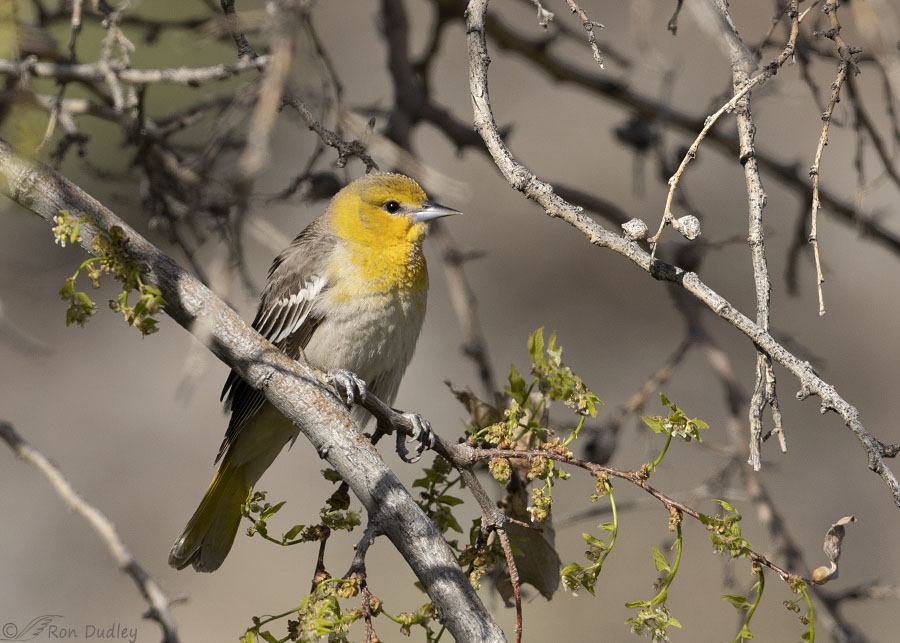The object of some hot-blooded competition.

1/3200, f/6.3, ISO 640, Canon R5, Canon EF500mm f/4L IS II USM + 1.4 tc, not baited, set up or called in
Two days ago, in a remote area of Box Elder County, I witnessed a few minutes of intense rivalry between two adult male Bullock’s Orioles as they competed for the attention of this adult female. For nearly 10 minutes the two males chased each other around within the tree they were in, and from tree to tree, as I tried to get my lens focused on either one of them.
But ultimately I failed miserably. They were just too damn fast for my skills, especially because I’m using a relatively new and complicated camera and my muscle memory just isn’t there yet.
Mostly this female just watched as she occasionally moved from perch to perch within the tree, presumably for a better view of the action. Usually I didn’t have a clear view of her either but this one time, for about 5 seconds, she was out in the open except for an out-of-focus twig in front of her right shoulder. I managed to get this single sharp photo of her before she moved on. She wasn’t very close but I was still happy to get the shot.
The entire experience was a lot of fun but it was frustrating too. Bullock’s Orioles occasionally come to my back yard but they’re usually attracted to my hummingbird feeder so I don’t post any photos I take of them there (you know, “not baited, set up or called in”). So I really wanted photos of at least one of those males!
Maybe next time.
Ron


The oriole is beautiful. Super photo, Ron. And, just so you know, I don’t consider a hummingbird feeder bait for an oriole. Seems more like an oriole stealing nectar intended for a hummer. I understand yet backyard photos from your yard are definitely welcome here by me.
I appreciate your perspective, Melanie. But if they’ve been drawn to my yard by food I’ve deliberately set out to attract birds, I consider them baited by definition.
Sounds like a very exciting 10 minutes, although she looks a little bored to me — as if she’s used to men fighting over her. 😉
I’m also happy to see your “ethics” labels on each shot. I wish more photographers and people out in wild spaces took them to heart.
“as if she’s used to men fighting over her”
Marty, I think I dated a girl or two like that in my younger days.
And thanks for what you said in your last paragraph.
❤️
She is beautiful and (anthromorphism to the fore) appears to be watching the proceedings with a very judgemental eye. Birds, and particularly small birds, move incredibly fast and unpredictably don’t they? A challenge that my eyes are not up to, let alone my arms and camera.
EC, yes, they’re both – incredibly fast and unpredictable. I didn’t realize how much so until I started trying to photograph them.
That looks more like fleece on her head and neck than feathers. They are not a particularly common bird here. I’ve seen the male so your photo is my first look at the female. That is one finely honed beak.
“That is one finely honed beak”
I was stuck by the same thing, Lyle. For me it really stood out.
Some other day, eh Ron?
AT this point it’s the most I can hope for.
Excellent photo Ron. Of course nature doesn’t provide her with the male’s brilliant colors, but she is one good looking bird even so. Good sharp photo. Whenever I tell photo friends about your site I tell them that I was most attracted due to your not baited, not called in etc ethics statement.
Thanks, Everett. I’m sure that many of my regular readers get tired of seeing that “not baited, set up or called in” line underneath my photos and truthfully, I don’t blame them.
But I’ll be including it for as long as I’m blogging. In my view it’s a necessary evil. Lots of folks would be blown away if they knew how many of the bird photos they see and like have been obtained using unscrupulous, often unethical and even illegal methods.
Amen – with you 100% on that – and the first I ever thought of or knew of such things was reading your posts – since then I have done research on such practices and have passed that knowledge on to many birders and non birders – thanks
Like trying to track the fighting Robins in/out/around trees bushes at the present tho seems to be slowing down. Nice shot of the female! 🙂
Thanks, Judy. I tried to photograph skirmishing robins yesterday, without success.
A good thing that the males have their gorgeous almost- orange coloring
to attract a girlfriend–if it were their awful-sounding scolding chatter, I don’t think we’d have any more baby Bullocks Orioles…. Sure do love to look at them, though !
Ha, interesting point Kris. I wouldn’t dispute it either… 🙂
Hello Ron, Just received todays blog with the Bullock Oriole photo displayed with initial introduction to your link. Great job! Don
Good.
She looks boringly amused 🙂
She might have been.
What a great experience you had!
Love the shot!
Thanks, Dick.